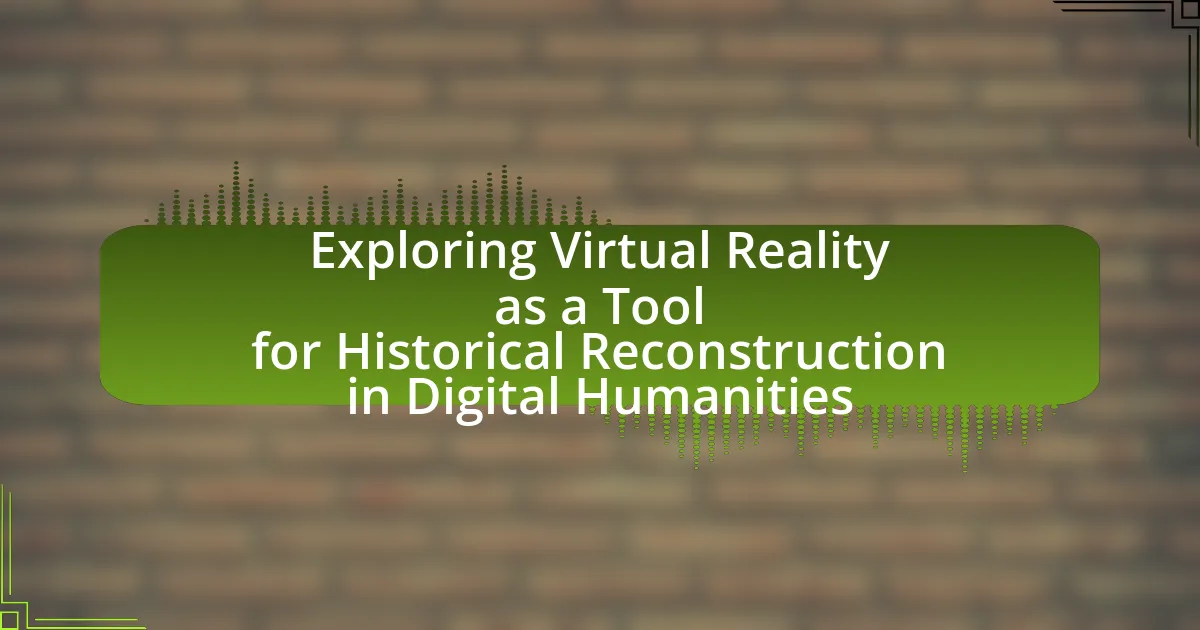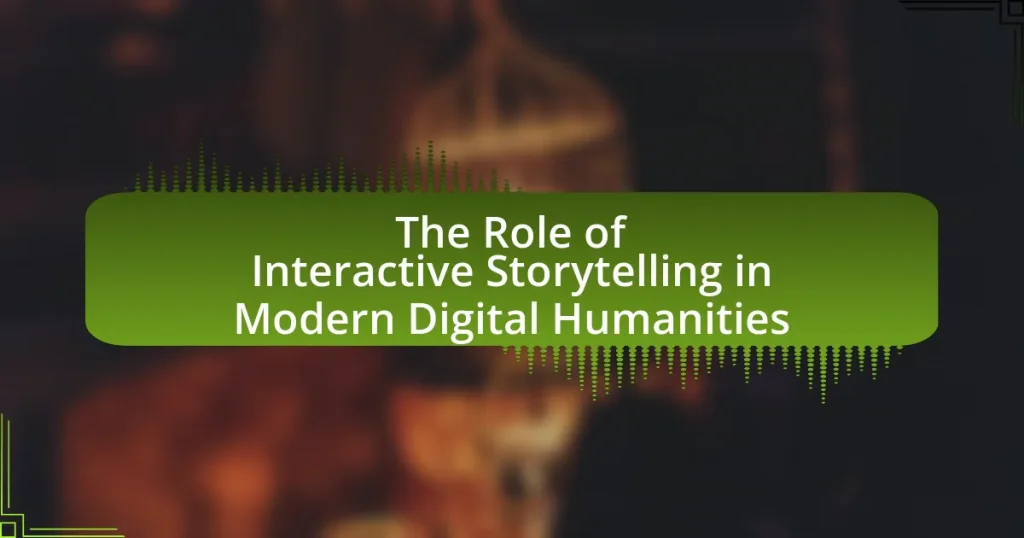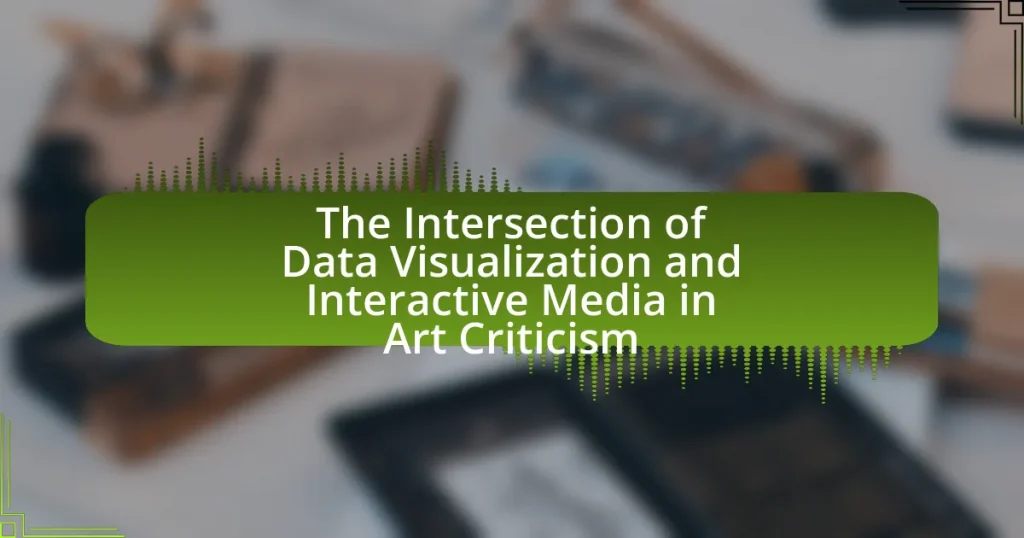Virtual Reality (VR) serves as a transformative tool for historical reconstruction within the field of Digital Humanities, enabling immersive experiences that enhance understanding of historical contexts and events. This article explores how VR technology allows users to interact with digitally recreated environments, such as ancient Pompeii, and engage with historical narratives in a more impactful manner than traditional methods. Key features of VR, including immersive environments and interactive simulations, facilitate deeper emotional and cognitive connections to history, while also addressing challenges related to accuracy, accessibility, and ethical considerations in representation. The article further examines the applications of VR in museums and educational institutions, highlighting its potential to foster interdisciplinary collaboration and improve retention of historical knowledge.
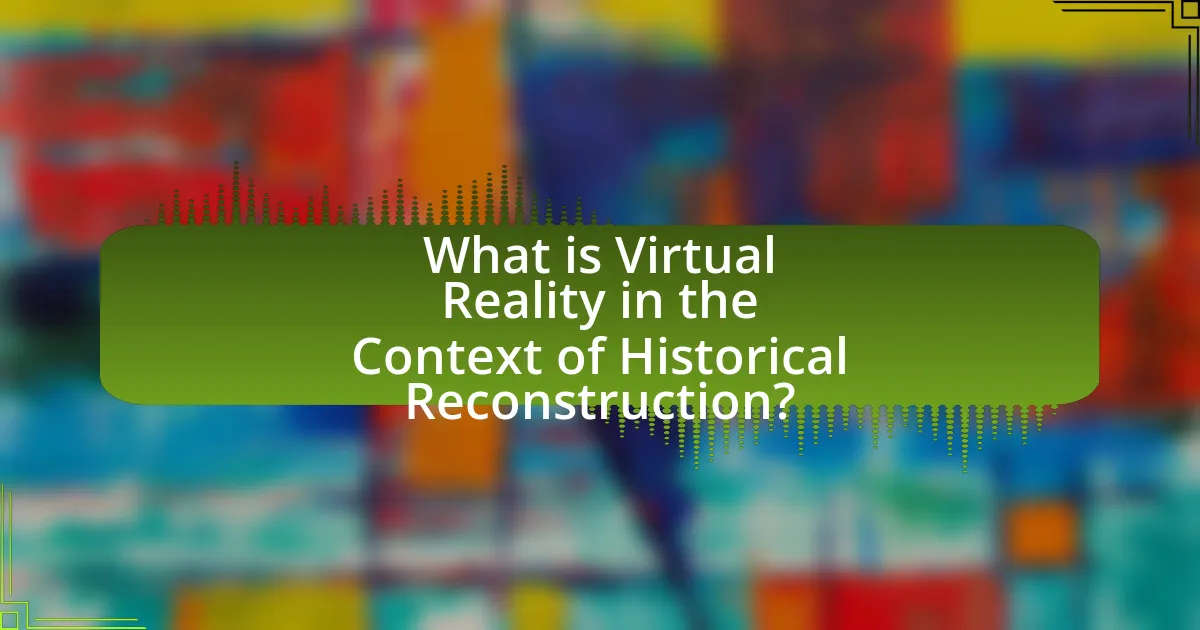
What is Virtual Reality in the Context of Historical Reconstruction?
Virtual Reality (VR) in the context of historical reconstruction is a technology that allows users to immerse themselves in digitally recreated historical environments and events. This immersive experience enables individuals to explore and interact with historical settings, artifacts, and scenarios in a way that traditional methods, such as textbooks or static displays, cannot achieve. For instance, projects like the Virtual Reality reconstruction of ancient Pompeii provide users with a detailed, interactive experience of the city as it existed before the eruption of Mount Vesuvius in 79 AD, allowing for a deeper understanding of its architecture and daily life. Such applications demonstrate VR’s potential to enhance educational experiences and historical research by providing a tangible connection to the past.
How does Virtual Reality enhance the understanding of historical events?
Virtual Reality (VR) enhances the understanding of historical events by providing immersive experiences that allow users to engage with historical contexts in a tangible way. This technology enables individuals to explore reconstructed environments, interact with historical figures, and witness events as if they were present, thereby deepening emotional and cognitive connections to the past. For instance, VR applications like “The Night Cafe,” which recreates Vincent van Gogh’s studio, allow users to experience the artist’s environment and gain insights into his life and work. Studies have shown that immersive learning experiences can improve retention and understanding of historical facts, as evidenced by research from the University of Maryland, which found that students who used VR for learning retained information better than those who learned through traditional methods.
What are the key features of Virtual Reality that aid in historical reconstruction?
The key features of Virtual Reality that aid in historical reconstruction include immersive environments, interactive simulations, and spatial awareness. Immersive environments allow users to experience historical settings as if they were physically present, enhancing engagement and understanding. Interactive simulations enable users to manipulate objects and scenarios, facilitating a deeper exploration of historical events and contexts. Spatial awareness is crucial as it provides a sense of scale and geography, helping users comprehend the relationships between different historical elements. These features collectively enhance the educational value of historical reconstructions, making them more accessible and impactful for users.
How does immersion in Virtual Reality impact the perception of history?
Immersion in Virtual Reality significantly enhances the perception of history by providing users with an experiential understanding of historical events and contexts. This immersive experience allows individuals to engage with historical narratives in a more interactive and emotionally resonant manner, leading to deeper cognitive and emotional connections with the past. Research indicates that VR can improve retention of historical facts and foster empathy by placing users in the shoes of historical figures or within significant events, as demonstrated in studies like “The Impact of Virtual Reality on Learning: A Review of the Literature” by Mikropoulos and Natsis, which highlights how immersive environments can facilitate a more profound understanding of complex historical scenarios.
Why is Virtual Reality considered a valuable tool in Digital Humanities?
Virtual Reality is considered a valuable tool in Digital Humanities because it enables immersive experiences that enhance the understanding of historical contexts and cultural artifacts. By allowing users to engage with 3D reconstructions of historical sites or events, Virtual Reality facilitates a deeper emotional and cognitive connection to the material, which traditional methods cannot achieve. Research has shown that immersive environments can improve retention and comprehension of historical information, as evidenced by projects like the Virtual Reality reconstruction of ancient Pompeii, which allows users to explore the city as it existed before the eruption of Mount Vesuvius. This capability to recreate and visualize complex historical narratives makes Virtual Reality an essential asset in the field of Digital Humanities.
What are the advantages of using Virtual Reality over traditional methods?
Virtual Reality (VR) offers immersive experiences that traditional methods cannot match, enhancing engagement and understanding. Unlike traditional methods, which often rely on static images or text, VR allows users to interact with 3D environments, providing a sense of presence and realism. Studies show that immersive learning environments can improve retention rates by up to 75%, compared to 10% for traditional lectures. This heightened engagement fosters deeper emotional connections to historical content, making it more memorable and impactful. Additionally, VR can simulate scenarios that are impossible or impractical to recreate in real life, such as historical events or ancient civilizations, allowing for a richer exploration of history.
How does Virtual Reality facilitate interdisciplinary collaboration in Digital Humanities?
Virtual Reality (VR) facilitates interdisciplinary collaboration in Digital Humanities by providing immersive environments that allow scholars from various fields to engage with historical data and artifacts in a shared space. This technology enables historians, artists, computer scientists, and educators to visualize complex information and collaborate on projects that require diverse expertise. For instance, VR can simulate historical events or environments, allowing participants to experience and analyze them collectively, which enhances understanding and fosters innovative approaches to research. Studies have shown that such collaborative VR experiences can lead to richer insights and more comprehensive interpretations of historical contexts, as evidenced by projects like the Virtual Reality and Augmented Reality in Cultural Heritage initiative, which brings together experts from multiple disciplines to create interactive historical reconstructions.
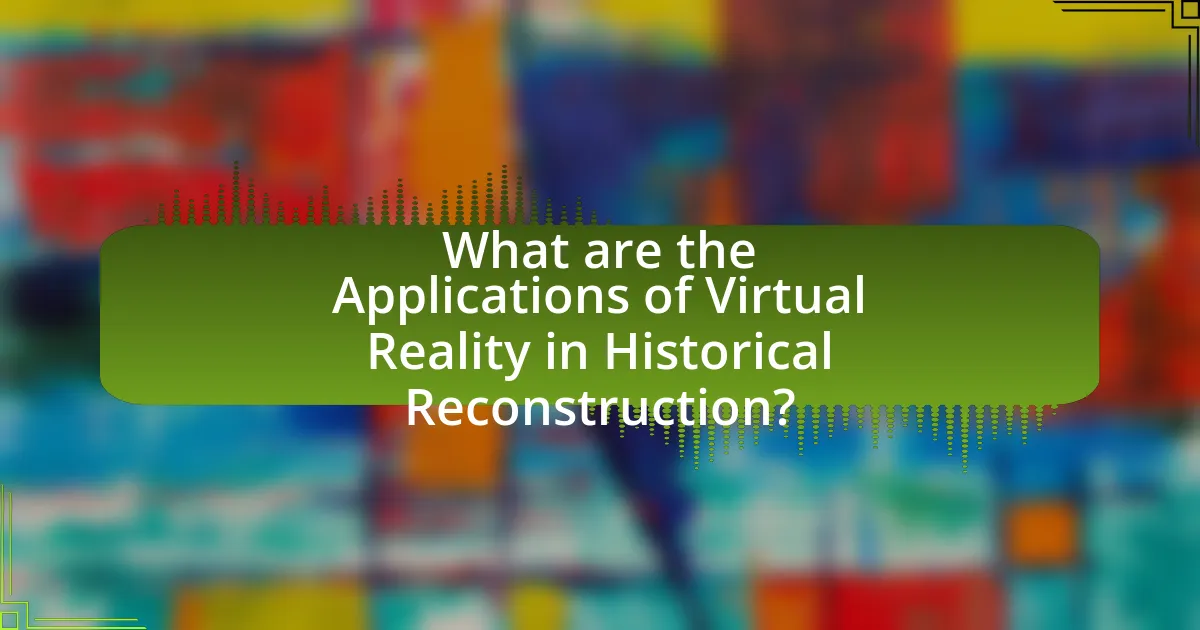
What are the Applications of Virtual Reality in Historical Reconstruction?
Virtual reality (VR) is applied in historical reconstruction to create immersive environments that allow users to experience and interact with historical events and settings. This technology enables historians and educators to visualize ancient civilizations, reconstruct significant events, and simulate historical scenarios, enhancing understanding and engagement. For instance, projects like the Virtual Reality Reconstruction of Pompeii allow users to explore the city as it appeared before the eruption of Mount Vesuvius, providing a tangible connection to the past. Additionally, VR can facilitate virtual tours of museums and historical sites, making history accessible to a broader audience.
How is Virtual Reality used in museums and educational institutions?
Virtual Reality (VR) is used in museums and educational institutions to create immersive experiences that enhance learning and engagement. Museums utilize VR to allow visitors to explore historical sites, artifacts, and exhibits in a simulated environment, providing a deeper understanding of cultural heritage. For example, the British Museum has implemented VR experiences that enable users to virtually walk through ancient civilizations, such as Ancient Egypt, thereby enriching the educational experience. Educational institutions leverage VR for interactive learning, enabling students to participate in virtual field trips or simulations that align with their curriculum, such as exploring the human anatomy or historical events. Research indicates that VR can improve retention rates and engagement levels among students, making it a valuable tool in both museum and educational settings.
What types of historical experiences are created through Virtual Reality in these settings?
Virtual Reality (VR) creates immersive historical experiences that allow users to engage with past events, environments, and figures in a tangible way. These experiences can include virtual reconstructions of significant historical sites, such as ancient cities or battlefields, enabling users to explore and interact with these locations as they would have appeared in their historical context. For instance, projects like “The Virtual Reality of Ancient Rome” allow users to walk through a digitally reconstructed Roman forum, providing insights into architectural styles and social interactions of that era. Additionally, VR can simulate pivotal moments in history, such as the signing of the Declaration of Independence, allowing users to witness and participate in these events, thereby enhancing their understanding of historical significance and context.
How do users interact with historical content in Virtual Reality environments?
Users interact with historical content in Virtual Reality (VR) environments primarily through immersive experiences that allow them to explore and engage with historical settings and events. This interaction is facilitated by the use of VR technologies that enable users to navigate 3D reconstructions of historical sites, participate in simulations of historical events, and manipulate virtual artifacts. Research indicates that such immersive experiences enhance learning and retention of historical knowledge, as users can visualize and contextualize information in a way that traditional media cannot provide. For instance, a study by Mikropoulos and Natsis (2011) found that students who engaged with historical content in VR environments demonstrated improved understanding and recall compared to those using conventional learning methods.
What role does Virtual Reality play in archaeological research?
Virtual Reality (VR) plays a significant role in archaeological research by enabling immersive exploration and visualization of historical sites and artifacts. This technology allows researchers to reconstruct ancient environments and simulate archaeological contexts, facilitating a deeper understanding of cultural heritage. For instance, projects like the Virtual Reality Archaeology Lab at the University of California, Berkeley, have demonstrated how VR can recreate sites such as Pompeii, allowing users to interact with the environment and gain insights into ancient urban planning and daily life. Such applications enhance educational outreach and public engagement, making archaeological findings more accessible and comprehensible to a broader audience.
How can Virtual Reality reconstruct archaeological sites for study and public engagement?
Virtual Reality (VR) can reconstruct archaeological sites by creating immersive, interactive 3D environments that allow users to explore and engage with historical contexts. This technology enables researchers to visualize and analyze spatial relationships, architectural features, and cultural artifacts in a way that traditional methods cannot. For instance, VR applications like “Rome Reborn” provide detailed reconstructions of ancient Rome, allowing both scholars and the public to experience the city as it once was, enhancing understanding and appreciation of historical significance. Studies have shown that such immersive experiences can improve learning outcomes and foster greater public interest in archaeology, as evidenced by increased visitor engagement in museums that utilize VR technology.
What technologies are integrated with Virtual Reality for archaeological applications?
Virtual Reality (VR) in archaeological applications integrates technologies such as 3D modeling, Geographic Information Systems (GIS), photogrammetry, and motion tracking. 3D modeling allows for the creation of detailed virtual reconstructions of archaeological sites, while GIS provides spatial analysis and mapping capabilities essential for understanding site contexts. Photogrammetry captures high-resolution images to generate accurate 3D models of artifacts and structures. Motion tracking enhances user interaction within virtual environments, enabling immersive experiences that simulate archaeological exploration. These technologies collectively enhance the visualization, analysis, and interpretation of archaeological data, facilitating deeper engagement with historical contexts.
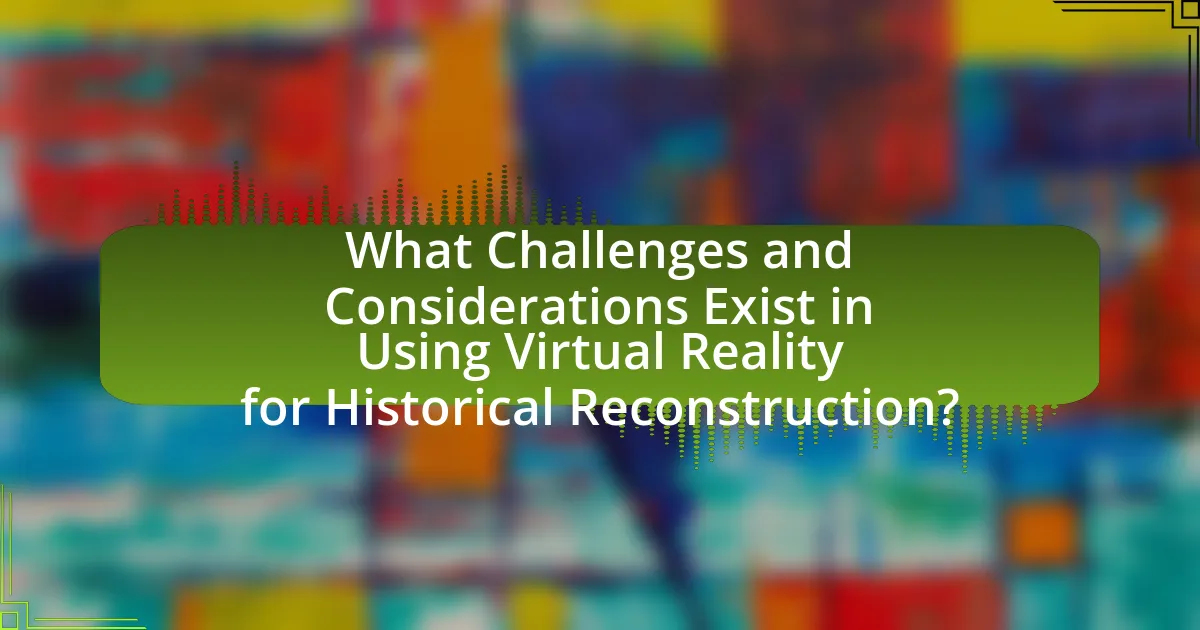
What Challenges and Considerations Exist in Using Virtual Reality for Historical Reconstruction?
Using virtual reality for historical reconstruction presents several challenges and considerations, including accuracy, accessibility, and user experience. Accuracy is critical, as historical representations must be based on reliable data and research; inaccuracies can mislead users about historical events or contexts. Accessibility poses a challenge, as not all users have access to the necessary technology or skills to engage with virtual reality, potentially limiting the audience. User experience is also vital; if the virtual environment is not intuitive or engaging, users may not fully immerse themselves in the historical context being presented. These challenges highlight the need for careful planning and execution in the development of virtual reality applications for historical reconstruction.
What are the technical limitations of Virtual Reality in historical contexts?
The technical limitations of Virtual Reality in historical contexts include issues related to data accuracy, hardware constraints, and user experience challenges. Data accuracy is often compromised due to the reliance on incomplete historical records, which can lead to misrepresentations in virtual environments. Hardware constraints, such as limited processing power and resolution, hinder the ability to create immersive and detailed reconstructions of historical sites. Additionally, user experience challenges arise from motion sickness and the need for intuitive interfaces, which can detract from the educational value of VR experiences. These limitations are evident in projects like the virtual reconstruction of Pompeii, where the fidelity of the environment is often limited by the available archaeological data and technology.
How do hardware and software constraints affect the quality of historical reconstructions?
Hardware and software constraints significantly limit the quality of historical reconstructions by restricting the detail, accuracy, and interactivity of the virtual environments created. For instance, inadequate processing power can lead to lower resolution graphics, resulting in less realistic representations of historical sites or artifacts. Additionally, limited software capabilities may hinder the integration of complex data sets, such as archaeological findings or historical documents, which are essential for creating accurate reconstructions. Research indicates that high-quality reconstructions require advanced hardware, such as powerful GPUs and sufficient memory, alongside sophisticated software tools that can handle large datasets and complex algorithms. Without these resources, the fidelity of the reconstructions suffers, impacting their educational and interpretive value in the field of digital humanities.
What are the challenges in accurately representing historical data in Virtual Reality?
Accurately representing historical data in Virtual Reality faces several challenges, primarily due to the limitations of available data, interpretative biases, and technological constraints. The first challenge is the scarcity and incompleteness of historical records, which can lead to gaps in the representation of events or cultures. For instance, many ancient civilizations left behind limited artifacts or written records, making it difficult to create a fully accurate VR depiction.
Another challenge is the subjective nature of historical interpretation; different historians may have varying perspectives on the same events, which can result in conflicting representations in VR. This subjectivity can affect how users perceive and engage with the historical content.
Technological constraints also play a significant role, as the fidelity of graphics, sound, and interactivity in VR can impact the immersive experience. High-quality representations require advanced technology and resources, which may not always be available.
Additionally, the need for user accessibility and inclusivity in VR experiences can complicate the representation of historical data, as different audiences may have varying levels of familiarity with the historical context being presented.
These challenges highlight the complexities involved in creating accurate and engaging historical representations in Virtual Reality.
How do ethical considerations impact the use of Virtual Reality in historical narratives?
Ethical considerations significantly impact the use of Virtual Reality (VR) in historical narratives by guiding the representation of sensitive historical events and ensuring respect for affected communities. For instance, VR experiences that depict traumatic events, such as the Holocaust or slavery, must navigate the ethical implications of portraying suffering and trauma, which can lead to re-traumatization of survivors or their descendants. Research by the University of Southern California emphasizes the importance of ethical frameworks in VR design, highlighting that developers must engage with historians and communities to create accurate and respectful representations. This engagement helps to avoid misrepresentation and promotes a more nuanced understanding of history, ensuring that VR serves as a tool for education rather than exploitation.
What responsibilities do creators have in representing history through Virtual Reality?
Creators have the responsibility to ensure accuracy and authenticity when representing history through Virtual Reality. This involves conducting thorough research to verify historical facts and contexts, as inaccuracies can mislead users and distort understanding. For instance, the use of primary sources, such as documents and artifacts, is essential to create a credible representation of historical events. Additionally, creators must consider the ethical implications of their portrayals, including the perspectives of marginalized groups, to provide a more inclusive narrative. By adhering to these responsibilities, creators can foster a deeper understanding of history and its complexities in the immersive environment of Virtual Reality.
How can biases in historical interpretation be addressed in Virtual Reality projects?
Biases in historical interpretation can be addressed in Virtual Reality projects by incorporating diverse perspectives and utilizing collaborative methodologies. Engaging historians, cultural experts, and community stakeholders ensures a multifaceted representation of history, reducing the risk of a singular narrative. For instance, projects like “The Virtual Reality of the American Civil War” have successfully integrated multiple viewpoints by consulting various historical sources and community narratives, which enhances the authenticity and inclusivity of the experience. Additionally, employing iterative design processes allows for continuous feedback and adjustments, further mitigating biases as the project evolves.
What Best Practices Should Be Followed When Implementing Virtual Reality for Historical Reconstruction?
Best practices for implementing virtual reality in historical reconstruction include ensuring historical accuracy, engaging user experience design, and incorporating interdisciplinary collaboration. Historical accuracy is crucial; utilizing primary sources, archaeological findings, and expert consultations helps create authentic representations. Engaging user experience design involves creating intuitive interfaces and interactive elements that enhance immersion, as studies show that user engagement increases learning retention. Interdisciplinary collaboration, involving historians, technologists, and designers, fosters diverse perspectives and expertise, leading to richer and more accurate reconstructions. These practices collectively enhance the effectiveness and educational value of virtual reality in historical contexts.
How can developers ensure accuracy and authenticity in their Virtual Reality experiences?
Developers can ensure accuracy and authenticity in their Virtual Reality experiences by utilizing rigorous research methodologies and collaborating with subject matter experts. This approach involves conducting thorough historical research, employing primary sources, and integrating expert feedback to create realistic environments and narratives. For instance, a study by the University of California, Berkeley, highlighted that VR experiences grounded in verified historical data significantly enhance user engagement and educational value. By adhering to these practices, developers can create immersive experiences that accurately reflect historical contexts and events.
What strategies can enhance user engagement and educational value in Virtual Reality historical projects?
Incorporating interactive storytelling and immersive experiences significantly enhances user engagement and educational value in Virtual Reality historical projects. Interactive storytelling allows users to make choices that influence the narrative, fostering a deeper emotional connection to historical events. For instance, projects like “The Night Cafe” enable users to explore Vincent van Gogh’s world, encouraging exploration and interaction with the environment, which enhances learning retention. Additionally, integrating gamification elements, such as challenges or rewards, can motivate users to engage more deeply with the content. Research indicates that gamified learning experiences can improve knowledge retention by up to 50%. Furthermore, providing contextual information through audio guides or augmented overlays can enrich the educational experience, allowing users to understand the significance of historical artifacts and settings. These strategies collectively create a more engaging and informative experience, making history accessible and compelling.
